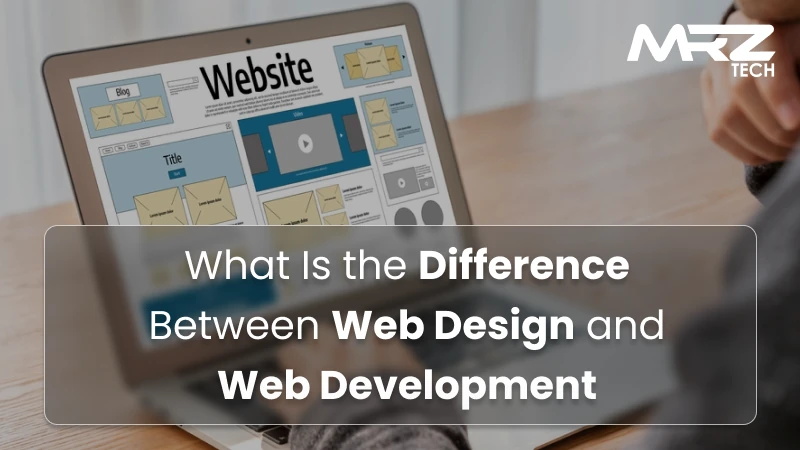5 min read

In the digital age, your website is often the first impression customers have of your brand. But have you ever wondered who’s behind making that site look great and function flawlessly? That’s where web design and web development come in.
Many people use these terms interchangeably — but they actually refer to two distinct disciplines that work hand-in-hand. In this guide, we’ll explain the difference between web design and web development , outline the unique roles of web designers and developers, and show how both skill sets combine to create modern, high-performing websites.
At the most basic level:
While designers handle the visual and creative side, developers bring those designs to life through code and technology. Both roles are essential in the website creation process.
Let’s dive deeper into each field.
Web design is the art and science of crafting the visual and interactive elements of a website. It encompasses UI (User Interface) and UX (User Experience) design — ensuring that visitors not only enjoy what they see but can also navigate the site effortlessly.
A web designer’s job is to translate a brand’s identity into a digital experience that captures attention and drives action.
When people ask, “What does a web designer do?”, the answer often goes beyond creating beautiful layouts. Web designers are responsible for:
A crucial aspect of understanding web design is recognizing the difference between UI and UX design.
In short, UI is about how things look, and UX is about how things work from a user’s perspective.
If web design defines the blueprint, web development builds the structure. It involves writing the code that makes a website functional, interactive, and dynamic. Developers transform static design mockups into responsive, feature-rich websites.
If web design defines the blueprint, web development builds the structure. It involves writing the code that makes a website functional, interactive, and dynamic. Developers transform static design mockups into responsive, feature-rich websites.
So, what does a web developer do exactly? Web developers handle the behind-the-scenes functionality that powers a website. Their tasks typically include:
The web development process generally follows these steps:
This process highlights how web design and development are interdependent — one cannot succeed without the other.
Web development is typically divided into two main areas: front-end and back-end. Let’s break down the difference between front-end and back-end development.
Front-End Development
Back-End Development
Developers working on both ends are known as Full-Stack Developers, capable of handling the entire web development process.
| Feature | Web Designer | Web Developer |
|---|---|---|
| Focus | Visual design & user experience | Technical structure & functionality |
| Key Skills | UI/UX, graphic design, color theory | Programming, databases, frameworks |
| Tools | Figma, Photoshop, Adobe XD | HTML, CSS, JavaScript, React, PHP |
| Output | Wireframes, mockups, prototypes | Fully functional websites |
| Goal | Attract and engage users visually | Build a secure, fast, and scalable website |
Understanding the web design vs web development difference helps businesses make better hiring decisions and ensures that both creative and technical needs are met.
Although web design vs programming seems like a contrast — art versus logic — the reality is they’re deeply interconnected. Designers must understand how programming affects layout feasibility, while developers must respect design principles to maintain visual integrity.
For instance:
This mutual understanding bridges creativity with technical innovation.
The difference between web design and web development often lies in mindset: designers think visually, while developers think logically.
Another common confusion is between web development and graphic design. While both are creative, they serve different purposes:
In other words, graphic design enhances branding, while web design and development build the interactive platform that carries that brand message.
The roles of web designer and developer complement each other perfectly. Successful websites are born from seamless collaboration between both. Here’s how they typically work together:
Effective communication ensures balance between form (design) and function (development).
A well-designed website without strong functionality is like a car without an engine. Conversely, a perfectly coded site with poor design will fail to engage users.
That’s why businesses must invest in both web design and development services. Together, they:
A professional web design team ensures aesthetics and accessibility, while skilled developers guarantee stability and usability — a winning combination for any modern website.
If you’re a business owner or aspiring tech professional, understanding when to hire each role is essential.
However, many modern professionals are hybrids — capable of both designing and coding, often called UI Developers or Full-Stack Designers.
To summarize, here’s the difference between web design and web development in one line:
Web design makes the website beautiful and user-friendly, while web development makes it functional and powerful.
Both disciplines are essential to crafting a website that’s visually appealing, responsive, fast, and easy to navigate.
Whether you’re exploring a career in design or development, or you’re a business looking to build a professional website, understanding the distinction — and collaboration — between these roles will set you up for long-term success.